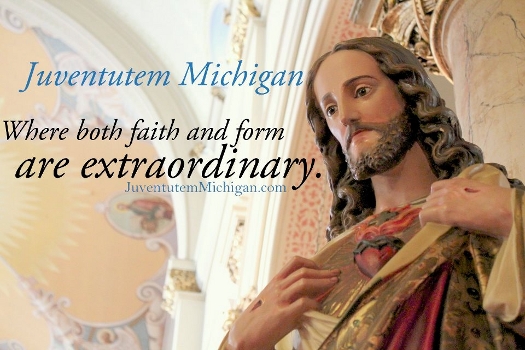
"I will go in unto the Altar of God
To God, Who giveth joy to my youth"
Tridentine Community News (June 2, 2013):

This weekend we observe the Feast of Corpus Christi, which is traditionally marked with a Eucharistic Procession. Holy Mother Church enriches this annual Feast by granting a Plenary Indulgence under the usual conditions to those who participate in a Eucharistic Procession on this day.
How we treat the Blessed Sacrament is one of the more visible ways in which we demonstrate our commitment to our Catholic Faith. If we truly believe that the consecrated bread and wine become the Body and Blood of our Lord Jesus Christ, then logically we should not treat the Sacred Species casually. In addition to the grand gestures displayed in ceremonies such as Benediction, in the Extraordinary Form of Holy Mass there are numerous smaller signs that the Blessed Sacrament is indeed something worthyof particular reverence and care.
In the center of the altar, a square cloth called a corporal is spread out. The actions of the Mass take place upon the corporal. The purpose of the corporal is to collect any particles of the Host that may break off or fall off. At various points during the Mass, the priest scrapes the corporal with the paten [see photo at right], in an effort to collect stray Particles.
The tabernacle may be covered with a veil, as a way of symbolizing the Veiling of the Sacred, much as the Holy of Holies in the Temple of Jerusalem was behind a veil.
In a High Mass, altar servers with torch candles kneel before the altar from the beginning of the Canon until the tabernacle is closed at the end of distribution of Holy Communion. In a Low Mass, a Sanctus Candle is placed on the altar during this same period. Both actions draw the faithful’s attention to the Real Presence of Christ upon the altar during this portion of the liturgy.
The elaborate and detailed Offertory prayers, the signs of the cross over the sacred species before and after the consecration, and the priest’s three prayers before Communion all serve to emphasize the significance of the act of Transubstantiation taking place.
After the consecration, every time the celebrant uncovers or covers the chalice, he genuflects in adoration of the Sacred Species. The chalice is covered to protect against foreign objects such as insects from getting into it. The Extraordinary Form Missal gives explicit instructions for what to do in case a bug does get in; every effort is made to protect the Sacrament.
Likewise, every time the tabernacle is opened or closed, the priest genuflects. Every time the priest crosses the center of the altar, such as during the incensations of the altar, he genuflects before the Blessed Sacrament in the tabernacle.
The purificator, a rectangular, folded cloth, is held by the chalice to wipe off any of the Precious Blood that may be in danger of dripping off the rim. It is also used to wipe off the priest’s fingers after the ablutions, the pouring of the wine and water over the celebrant’s fingers after Holy Communion.
From the consecration until the ablutions, the priest holds his thumbs and first fingers together. This ensures that any particles of the Host that may have adhered to his fingers do not flake off onto the floor, the missal, or any place other than the corporal or the ciborium. The main reason why a deacon or altar server stands next to the priest during the Mass is to turn the pages of the book, avoiding the risk that the priest will drop particles of the Host onto the missal.
Holy Communion is distributed at the Communion Rail, kneeling and on the tongue. Only the consecrated hands of a priest or deacon may touch the Blessed Sacrament.
A server accompanies the priest distributing Holy Communion with a paten, held under each communicant’s mouth to catch a dropped Host or Particle. If there is no server, the faithful may pass a paten among themselves during the distribution to accomplish the same purpose. The Communion Rail may be covered with a Communion Cloth, as a further aid in making dropped Hosts visible, reducing the likelihood that they will drop to the floor. If a Host does drop to the floor, the priest covers it with a purificator, and after Mass removes the Host and either consumes It or drops It into the little vial of water on the altar so that It eventually dissolves. He then cleans the place where It fell on the floor with Holy Water.
There are three ablutions in the Extraordinary Form. First, wine is poured into the chalice, which the celebrant may in turn pour into the ciborium. The priest drinks the wine and wipes down the sacred vessels with the purificator, to ensure no consecrated species remains. Then wine and water are poured over the priest’s fingers to purify them as he holds them over the chalice.
If Communion is ever distributed outside of Mass, or within a liturgical service that is not a Mass, such as on Good Friday, the faithful who are to receive it pray the Pater Noster, the Confíteor, and the Dómine, non sum dignus before receiving. There is never a hurry to consume the Blessed Sacrament. Catholics have a treasure of inestimable value in the Blessed Sacrament. It is an act of common sense as well as devotion for us to treat our Lord Really Present with the utmost reverence and adoration.
Tridentine Masses This Coming Week
- Mon. 06/03 7:00 PM: Low Mass at St. Josaphat (Feria [Celebrant may choose a Votive Mass])
- Tue. 06/04 7:00 PM: Low Mass at Assumption-Windsor (St. Francis Caracciolo, Confessor)
- Fri. 06/07 7:00 PM: Low Mass at St. Josaphat (Sacred Heart of Jesus [First Friday])


No comments:
Post a Comment